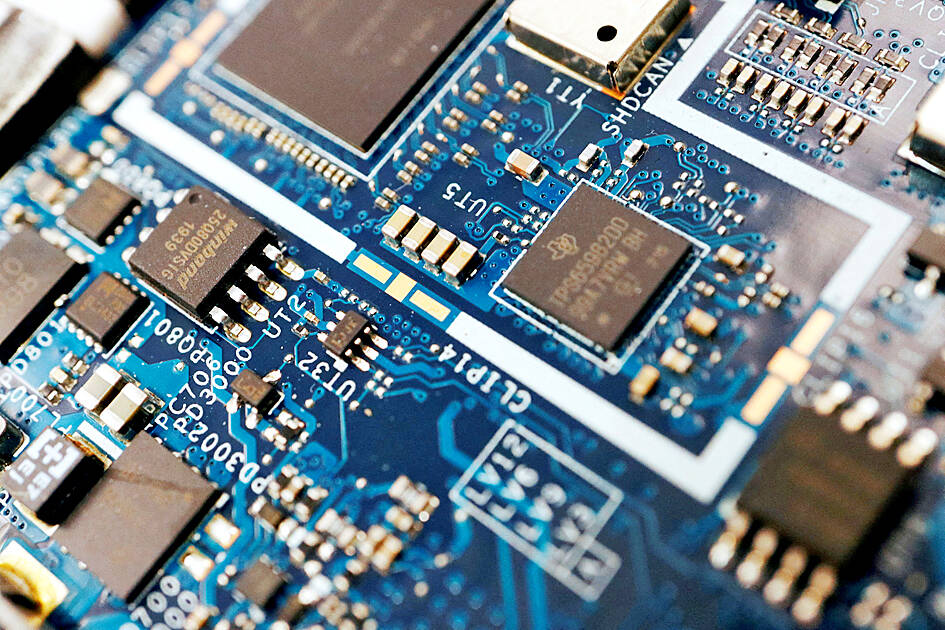Taiwan is forecast to retain its position as having the second-largest semiconductor capacity in the world this year, with production capacity set to increase more than 4 percent from a year earlier, the global semiconductor trade association SEMI said on Thursday.
The global semiconductor industry is expected to enjoy a recovery in demand after a slump last year, as many countries are coming up with incentives to encourage production expansion by building new wafer foundry plants and introducing new equipment, SEMI global chief marketing officer and Taiwan president Terry Tsao (曹世綸) said in a statement.
SEMI’s latest World Fab Forecast report said global semiconductor capacity is expected to rise 6.4 percent this year and surpass 30 million wafers per month to a new high after rising 5.5 percent to 29.6 wafers per month last year.

Photo: Reuters
This year, 42 new semiconductor fabs are to start mass production, compared with 11 last year, it said.
“Resurgent market demand and increased government incentives worldwide are powering an upsurge in fab investments in key chipmaking regions and the projected 6.4 percent rise in global capacity for 2024,” SEMI president and CEO Ajit Manocha said in the report.
“The heightened global attention on the strategic importance of semiconductor manufacturing to national and economic security is a key catalyst of the trend,” Manocha added.
Taiwan’s output is expected to reach 5.7 million wafers per month this year, up 4.2 percent from a year earlier after an anticipated year-on-year increase of 5.6 percent last year, which pushed it to 5.4 million wafers per month, the report said.
China is expected to raise its capacity to 8.6 million units per month this year, up 13 percent from a year earlier, to take the top spot in the world on the back of government funding and other incentives, the report said.
Chinese semiconductor suppliers are projected to add 18 wafer fabs this year, SEMI said.
South Korea’s capacity is expected to rise 5.4 percent from a year earlier to 5.10 million wafers per month, giving it the third-largest capacity in the world, the report said.
Japan is expected to boost its output by about 2 percent from a year earlier to 4.70 million units per month, taking the No. 4 spot, it added.
In the Americas, semiconductor capacity is expected to grow 6 percent from a year earlier to 3.10 million wafers per month, while capacity in Europe and the Middle East is to rise 3.6 percent to 2.70 million units per month and capacity in Southeast Asia is forecast to rise 4 percent to 1.70 million units per month, it said.
The pure wafer foundry segment is expected to become the largest buyer of production equipment for its expansion, with capacity likely to hit 10.20 million wafers per month, up from the anticipated 9.3 million last year, SEMI said.
As for the memorychip segment, DRAM suppliers are expected to raise capacity by 2 percent to 3.8 million wafers per month and an additional 5 percent to 4 million units per month next year, it said.

Six Taiwanese companies, including contract chipmaker Taiwan Semiconductor Manufacturing Co. (TSMC), made the 2025 Fortune Global 500 list of the world’s largest firms by revenue. In a report published by New York-based Fortune magazine on Tuesday, Hon Hai Precision Industry Co. (better known as Foxconn) ranked highest among Taiwanese firms, placing 28th with revenue of US$213.69 billion. Up 60 spots from last year, TSMC rose 60 places to reach No. 126 with US$90.16 billion in revenue, followed by Quanta Computer Inc. at 348th, Pegatron Corp. at 461st, CPC Corp., Taiwan at 494th and Wistron Corp. at 496th. According to Fortune, the world’s

NEW PRODUCTS: MediaTek plans to roll out new products this quarter, including a flagship mobile phone chip and a GB10 chip that it is codeveloping with Nvidia Corp MediaTek Inc (聯發科) yesterday projected that revenue this quarter would dip by 7 to 13 percent to between NT$130.1 billion and NT$140 billion (US$4.38 billion and US$4.71 billion), compared with NT$150.37 billion last quarter, which it attributed to subdued front-loading demand and unfavorable foreign exchange rates. The Hsinchu-based chip designer said that the forecast factored in the negative effects of an estimated 6 percent appreciation of the New Taiwan dollar against the greenback. “As some demand has been pulled into the first half of the year and resulted in a different quarterly pattern, we expect the third quarter revenue to decline sequentially,”

WEAKER ACTIVITY: The sharpest deterioration was seen in the electronics and optical components sector, with the production index falling 13.2 points to 44.5 Taiwan’s manufacturing sector last month contracted for a second consecutive month, with the purchasing managers’ index (PMI) slipping to 48, reflecting ongoing caution over trade uncertainties, the Chung-Hua Institution for Economic Research (CIER, 中華經濟研究院) said yesterday. The decline reflects growing caution among companies amid uncertainty surrounding US tariffs, semiconductor duties and automotive import levies, and it is also likely linked to fading front-loading activity, CIER president Lien Hsien-ming (連賢明) said. “Some clients have started shifting orders to Southeast Asian countries where tariff regimes are already clear,” Lien told a news conference. Firms across the supply chain are also lowering stock levels to mitigate

DIVERSIFYING: Taiwanese investors are reassessing their preference for US dollar assets and moving toward Europe amid a global shift away from the greenback Taiwanese investors are reassessing their long-held preference for US-dollar assets, shifting their bets to Europe in the latest move by global investors away from the greenback. Taiwanese funds holding European assets have seen an influx of investments recently, pushing their combined value to NT$13.7 billion (US$461 million) as of the end of last month, the highest since 2019, according to data compiled by Bloomberg. Over the first half of this year, Taiwanese investors have also poured NT$14.1 billion into Europe-focused funds based overseas, bringing total assets up to NT$134.8 billion, according to data from the Securities Investment Trust and Consulting Association (SITCA),